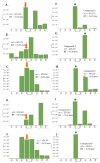Targeted Isolation of Anti-Trypanosomal Naphthofuran-Quinone Compounds from the Mangrove Plant Avicennia lanata
- PMID: 33371387
- PMCID: PMC7767399
- DOI: 10.3390/md18120661
Targeted Isolation of Anti-Trypanosomal Naphthofuran-Quinone Compounds from the Mangrove Plant Avicennia lanata
Abstract
The discovery of new secondary metabolites from natural origins has become more challenging in natural products research. Different approaches have been applied to target the isolation of new bioactive metabolites from plant extracts. In this study, bioactive natural products were isolated from the crude organic extract of the mangrove plant Avicennia lanata collected from the east coast of Peninsular Malaysia in the Setiu Wetlands, Terengganu, using HRESI-LCMS-based metabolomics-guided isolation and fractionation. Isolation work on the crude extract A. lanata used high-throughput chromatographic techniques to give two new naphthofuranquinone derivatives, hydroxyavicenol C (1) and glycosemiquinone (2), along with the known compounds avicenol C (3), avicequinone C (4), glycoquinone (5), taraxerone (6), taraxerol (7), β-sitosterol (8) and stigmasterol (9). The elucidation and identification of the targeted bioactive compounds used 1D and 2D-NMR and mass spectrometry. Except for 6-9, all isolated naphthoquinone compounds (1-5) from the mangrove plant A. lanata showed significant anti-trypanosomal activity on Trypanosoma brucei brucei with MIC values of 3.12-12.5 μM. Preliminary cytotoxicity screening against normal prostate cells (PNT2A) was also performed. All compounds exhibited low cytotoxicity, with compounds 3 and 4 showing moderate cytotoxicity of 78.3% and 68.6% of the control values at 100 μg/mL, respectively.
Keywords: NMR; dereplication; high-throughput chromatographic; mangrove; mass spectrometry; metabolic profiling; multivariate analysis.
Conflict of interest statement
The authors declare no conflict of interest.
Figures






Similar articles
-
Metabolomics-Guided Isolation of Anti-Trypanosomal Compounds from Endophytic Fungi of the Mangrove plant Avicennia Lanata.Curr Med Chem. 2020;27(11):1815-1835. doi: 10.2174/0929867326666190704130105. Curr Med Chem. 2020. PMID: 31272343
-
Unusual naphthoquinone derivatives from the twigs of Avicennia marina.J Nat Prod. 2007 Jun;70(6):923-7. doi: 10.1021/np060587g. Epub 2007 May 15. J Nat Prod. 2007. PMID: 17500572
-
Activity of extracts and naphthoquinones from Kigelia pinnata against Trypanosoma brucei brucei and Trypanosoma brucei rhodesiense.Planta Med. 1999 Aug;65(6):536-40. doi: 10.1055/s-1999-14011. Planta Med. 1999. PMID: 10483374
-
Antimicrobial compounds from mangrove plants: A pharmaceutical prospective.Chin J Integr Med. 2014 Apr;20(4):311-20. doi: 10.1007/s11655-014-1747-0. Epub 2014 Jan 30. Chin J Integr Med. 2014. PMID: 24481742 Review.
-
Flavonoid-derived Privileged Scaffolds in anti-Trypanosoma brucei Drug Discovery.Curr Drug Targets. 2019;20(12):1295-1314. doi: 10.2174/1389450120666190618114857. Curr Drug Targets. 2019. PMID: 31215385 Review.
Cited by
-
Targeted Isolation of Antibiofilm Compounds from Halophytic Endophyte Bacillus velezensis 7NPB-3B Using LC-HR-MS-Based Metabolomics.Microorganisms. 2024 Feb 19;12(2):413. doi: 10.3390/microorganisms12020413. Microorganisms. 2024. PMID: 38399817 Free PMC article.
-
Exploring the Mangrove Fruit: From the Phytochemicals to Functional Food Development and the Current Progress in the Middle East.Mar Drugs. 2022 Apr 28;20(5):303. doi: 10.3390/md20050303. Mar Drugs. 2022. PMID: 35621954 Free PMC article. Review.
-
Biological Secondary Metabolites from the Lumnitzera littorea-Derived Fungus Penicillium oxalicum HLLG-13.Mar Drugs. 2022 Dec 27;21(1):22. doi: 10.3390/md21010022. Mar Drugs. 2022. PMID: 36662195 Free PMC article.
-
Defining the biomarkers in anti-MRSA fractions of soil Streptomycetes by multivariate analysis.Antonie Van Leeuwenhoek. 2025 May 10;118(6):77. doi: 10.1007/s10482-025-02087-8. Antonie Van Leeuwenhoek. 2025. PMID: 40347296
References
-
- Bandaranayake W.M. Bioactivities, bioactive compounds and chemical constituents of mangrove plants. Wetl. Ecol. Manag. 2002;10:421–452. doi: 10.1023/A:1021397624349. - DOI
-
- Duke N., Ball M., Ellison J. Factors influencing biodiversity and distributional gradients in mangroves. Global Ecol. Biogeogr. Lett. 1998;7:27–47. doi: 10.2307/2997695. - DOI
-
- Peter K.L.N., Sivasothi N. A Guide to the Mangroves of Singapore 1: The Ecosystem & Plant. Diversity. Singapore Science Centre; Singapore: 1999. revised edition (2002)
MeSH terms
Substances
LinkOut - more resources
Full Text Sources

